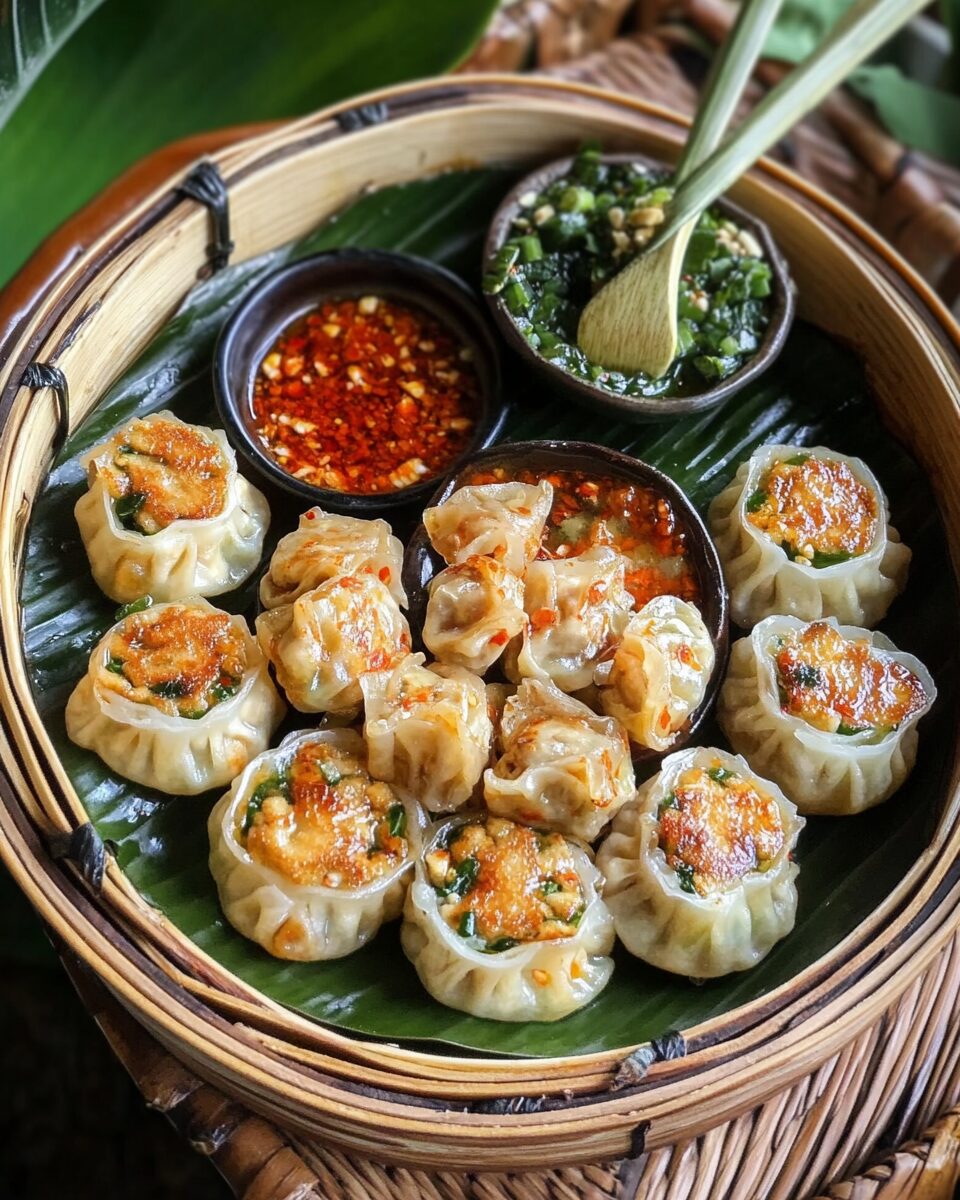Kanom Jeeb, with their delicate, thin wrappers and savory filling, provide the perfect balance of flavors. The ground pork, shrimp, and water chestnuts meld together beautifully, creating a harmonious bite. The tender dumplings are a true testament to the art of Thai street food, delighting every taste bud with each tender morsel.
These steamed dumplings offer a simple yet profound culinary experience. Their subtle flavors and delightful textures make them a great addition to any meal or a perfect snack to share with friends and family. If you’re craving something fresh, light, and bursting with flavor, Kanom Jeeb is an easy recipe that delivers every time.
Full Recipe:
- 250g ground pork
- 1/2 cup shrimp, finely chopped
- 1/4 cup water chestnuts, chopped
- 2 tablespoons oyster sauce
- 1 tablespoon soy sauce
- 1 tablespoon sesame oil
- 1 tablespoon cornstarch
- 1 tablespoon finely minced garlic
- 1 tablespoon finely minced ginger
- 1/2 teaspoon white pepper
- 1/4 cup chopped cilantro
- 30 dumpling wrappers (can be purchased at an Asian market)
- Freshly ground black pepper to taste
Directions:
- In a large bowl, mix together the ground pork, finely chopped shrimp, water chestnuts, garlic, ginger, and cilantro.
- Stir in the oyster sauce, soy sauce, sesame oil, cornstarch, white pepper, and a pinch of black pepper. Mix everything thoroughly until it forms a smooth filling.
- Lay out the dumpling wrappers on a clean, flat surface. Spoon about a teaspoon of filling into the center of each wrapper.
- Wet the edges of the wrapper with a little water, then fold the wrapper over the filling, pressing the edges together to form a half-moon shape.
- Steam the dumplings for about 15-20 minutes until the wrappers become translucent, and the filling is fully cooked.
- Serve hot with a side of soy sauce or your favorite dipping sauce.
Prep Time: 20 minutes | Cooking Time: 20 minutes | Total Time: 40 minutes
Kcal: 200 kcal | Servings: 4-6 servings
Introduction to Kanom Jeeb
Kanom Jeeb, often referred to as Thai dumplings, is a beloved dish in Thai cuisine, closely resembling Chinese pork siu mai. These dumplings are commonly served in Thai restaurants, dim sum carts, and street food stalls across Thailand. They are steamed to perfection, delivering a tender bite packed with flavorful fillings. The key to their authenticity lies in the combination of minced pork, shrimp, or both, seasoned with a variety of aromatic herbs and spices. Served with a savory dipping sauce, Kanom Jeeb is an appetizer that always leaves a lasting impression.
Origin and Cultural Significance
The origins of Kanom Jeeb are deeply rooted in Chinese cuisine, specifically the siu mai dumplings that have been a staple in dim sum culture for centuries. However, the Thai version of these dumplings has evolved to reflect the local flavors and culinary techniques. The Thai name “Kanom Jeeb” translates to “pleated dumpling,” referring to the traditional pleats that form around the wrapper when it is sealed. These dumplings are popular in Thai households as well as in restaurants, where they are a classic choice for appetizers.
The Versatility of Kanom Jeeb Fillings
One of the best things about Kanom Jeeb is its versatility. While the traditional filling consists of minced pork and shrimp, there are countless variations that cater to different tastes and dietary preferences. In addition to pork and shrimp, you can experiment with other proteins like minced chicken or beef. Vegetarians can easily swap in a mix of vegetables like cabbage, mushrooms, and spinach, making it a suitable option for those avoiding meat.
To enhance the flavor profile, many chefs incorporate additional ingredients such as finely chopped carrots, green onions, and cilantro, which contribute to the texture and aroma of the dumplings. A key seasoning in the filling is the use of golden mountain sauce, oyster sauce, and a hint of sesame oil, which impart a savory umami taste that perfectly complements the meat.
Dumpling Wrappers: The Essential Component
The dumpling wrappers used in Kanom Jeeb play a vital role in the overall experience. Made from thin, silky dough, these wrappers are perfect for folding around the flavorful filling. While pre-made wonton wrappers are commonly used for convenience, making homemade wrappers can elevate the dish to the next level. For those outside of Asia, frozen wrappers are readily available in Asian grocery stores, which makes preparing Kanom Jeeb more accessible than ever.
Cooking Techniques: Steaming, Frying, and Boiling
Kanom Jeeb is traditionally steamed in a bamboo steamer, allowing the dumplings to cook gently and retain their delicate texture. The steam softens the wrapper while keeping the filling juicy and tender. This method is not only the most common but also the healthiest way to prepare these dumplings, as it doesn’t require any added oils or fats.
For those looking for a different texture, Kanom Jeeb can also be deep-fried, which adds a crispy, golden exterior while maintaining a soft and flavorful interior. Some even prefer to boil the dumplings, offering another take on the dish that still preserves the rich flavors. Each method of cooking yields a unique result, giving you plenty of options depending on your personal preferences.
The Importance of the Dipping Sauce
No Thai dumpling experience would be complete without the right dipping sauce. The ideal sauce should complement the dumplings’ savory flavors without overpowering them. While soy-based sauces are a popular option, many people prefer a tangy and sweet dipping sauce, such as Thai sweet chili sauce or a homemade wonton dipping sauce. The balance of sweet, salty, and spicy in these sauces perfectly contrasts the rich flavors of the dumplings, making every bite more enjoyable.
Serving Suggestions and Pairings
Kanom Jeeb is often served as an appetizer, but it can also be enjoyed as a snack or light meal. For a full Thai dining experience, these dumplings pair wonderfully with other Thai appetizers such as Thai chicken satay, Thai shrimp rolls with peanut sauce, or Thai fish cakes. You can also serve them alongside a bowl of hot and fragrant Thai soup, like Tom Yum, to create a well-rounded meal. The versatility of Kanom Jeeb means it can be enjoyed in various contexts, from casual family meals to more formal gatherings.
Storing and Reheating Kanom Jeeb
If you have leftovers, Kanom Jeeb can be easily stored and enjoyed later. After cooling, place the dumplings in an airtight container and refrigerate them for up to two days. For longer storage, you can freeze the dumplings. Simply lay them out on a tray to freeze individually, and once frozen, transfer them to a freezer bag. When you’re ready to enjoy them, steam or fry them directly from the freezer without the need to thaw them first.
Customization and Dietary Options
Kanom Jeeb is highly customizable, making it a dish that can be tailored to meet different dietary needs. If you’re vegetarian or vegan, simply replace the meat with your choice of vegetables or tofu. Additionally, if you follow a gluten-free diet, you can use gluten-free wrappers made from rice flour or tapioca starch. The flexibility of this recipe ensures that everyone can enjoy a delicious, authentic taste of Thailand.
Conclusion
Kanom Jeeb is more than just a dumpling; it’s a culinary experience that encapsulates the essence of Thai cooking. The combination of tender, flavorful filling, delicate dumpling wrappers, and the savory dipping sauce creates a dish that is both satisfying and memorable. Whether you’re making it for a special occasion or simply craving a tasty snack, these Thai dumplings are sure to impress. Their versatility, ease of preparation, and delicious flavor make them a perfect addition to any meal. So, grab your steamer and prepare to indulge in the delightful flavors of Kanom Jeeb – a dish that brings a little piece of Thailand into your kitchen.





